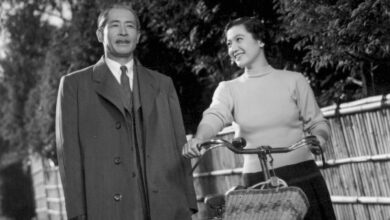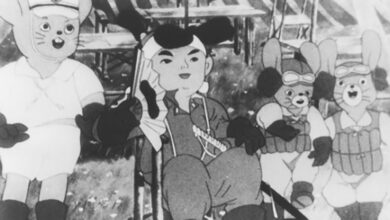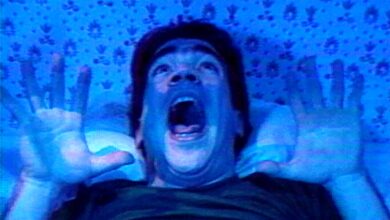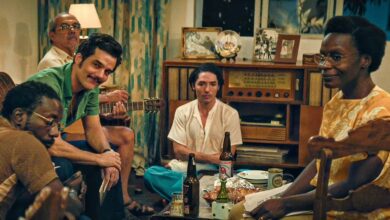
This article appeared in the August 28, 2024 edition of The Film Comment Letter, our free weekly newsletter featuring original film criticism and writing. Sign up for the Letter here.
From August 31–September 1, 2024, Film Comment co-presented, with Adam Shatz, The Rebel’s Cinema—Frantz Fanon on Screen, a four-day series of screenings and talks exploring Frantz Fanon’s echoes in cinema, held at Film at Lincoln Center, Maysles Documentary Center, the Brooklyn Academy of Music, and Anthology Film Archives. This essay serves as a program note for the series.

Frantz Fanon’s duties as a revolutionary, a practicing psychiatrist, and a writer left him little time for hobbies. But when he wasn’t at the hospital or attending meetings of Algeria’s National Liberation Front (FLN)—or writing his electrifying manifestos on decolonization—one of the things he most enjoyed was going to the movies. He sat as close to the screen as possible (he hated wearing glasses), and would sometimes give his patients money to see films. He loved Alain Resnais’s Hiroshima mon amour (1959).
The cinema has returned his affection, finding in Fanon’s life and work a rich repository of inspiration, images, and ideas. Among the filmmakers who have alluded to Fanon in their work, or cited him as an influence, are Gillo Pontecorvo, Ousmane Sembène, Claude Lanzmann, Glauber Rocha, Claire Denis, Med Hondo, and Sarah Maldoror. Their interest in the author of Black Skin, White Masks and The Wretched of the Earth is hardly surprising. Fanon’s writings on racism, colonialism, and national liberation struggles have the most fundamental elements of picture-making: a riveting plot (the existential, violent drama of decolonization), intense emotions, and arresting imagery. The visual archive of anti-colonial struggle is scarcely imaginable without his stark account of the brutally segregated colonial city in The Wretched of the Earth, or his description, in A Dying Colonialism, of Algerian women removing their veils and venturing into the European city on resistance missions for the FLN. If you’re experiencing a sense of déjà vu reading this, it’s probably because you’ve watched these scenes in Pontecorvo’s 1966 film The Battle of Algiers, a portrait of the Algerian resistance that owed much to the Italian filmmaker’s readings of Fanon.
But there’s more to Fanon’s cinematic allure than his storytelling verve and liberationist politics. There is also his unflinching insight into the “lived experience” of racial and colonial oppression—not least its dream life, the traces deposited in the psyches of both oppressed and oppressor: in their desires, fantasies, and hallucinations. Consider, for example, Sembène’s Black Girl, also released in 1966, and as intimate as Pontecorvo’s film is epic. Here we have a tragic tale of a single life—that of a young Senegalese woman who goes to work for a white family in Antibes, France, with dreams of a better life in the metropole, only to find herself subject to racist humiliation and psychological injury. She ends up killing herself, but not before reclaiming an African mask that she has given her host family as a gift. In a haunting finale, the mask becomes a symbol of her defiant spirit, and of African resistance. Sembène was a close reader of Fanon, and in its treatment of the psychic terrain of racial domination, Black Girl resembles one of Fanon’s case studies.
Fanon developed his understanding of the dynamics of oppression while practicing psychiatry in what I call “the rebel’s clinic.” He wrote about the sexual fantasies of the colonized, about colonial torturers who abuse their wives and children, about rebels who take pride in their record of combat but are also haunted by the killings in which they took part—about, in short, the dreams, nightmares, and traumatic memories that are the obsession of both psychoanalysts and filmmakers. The television host played by Daniel Auteuil in Michael Haneke’s Caché (2005), who suffers from guilt over his behavior as a child during the Algerian War, yet who is also violently indignant that he should be reminded of it, might have been one of Fanon’s patients.
Fanon was, of course, a freedom fighter, determined to liberate the African continent from colonial rule and imperialism. Yet he also emphasized that decolonization was not a simple affair, and that it faced threats of its own making—above all, the rise of new and avaricious elites, eager to take the place of the colonizer, and disinclined to share power with those who had suffered most from colonial rule, the masses. That sense of difficulty, of the need for vigilance and creativity in what was sure to be a long, postcolonial struggle, is another of Fanon’s gifts to the cinema—notably the Third Cinema of filmmakers like Sembène, Maldoror, and Hondo, all of whom have insisted that freedom is a never-ending project, not a prize that is won overnight.
The Rebel’s Cinema—Frantz Fanon on Screen, a series I conceived in collaboration with Film Comment, is designed to evoke the “specters of Fanon” in the cinema produced since his death in 1961. It focuses on the enduring presence of a Fanonian imaginary, rather than drawing attention to films that are specifically about Fanon, such as Isaac Julien’s essayistic portrait Frantz Fanon: Black Skin, White Mask (1995); Göran Hugo Olsson’s documentary Concerning Violence (2014); or Abdenour Zahzah’s recent film, True Chronicles of the Blida Joinville Psychiatric Hospital in the Last Century, When Dr Frantz Fanon Was Head of the Fifth Ward between 1953 and 1956.
Fanon was, to be sure, a character worthy of a major biopic. His first American biographer, Peter Geismar, tried to sell a screenplay about him—co-written with the Cold War Washington Post columnist Joseph Alsop—to a Hollywood studio. Melville Tucker, a producer at Universal Studios, responded that he and his colleagues wanted to know more about Fanon, including whether he displayed any personal tendencies towards violence, and whether he liked to dance. Geismar died prematurely of cancer, and the film never got off the ground. But his influence in cinema is, we believe, better measured by the films where his thinking is present and yet never explicitly mentioned.
This is why we decided to open the series with a screening of Michelangelo Antonioni’s 1975 drama The Passenger, in which Jack Nicholson plays an American war reporter who assumes the identity of an arms trader working with rebels in Chad. Antonioni’s preoccupations with identity and alienation could scarcely be more different from Fanon’s understanding of anti-colonial disalienation, and yet there is an encounter here between Nicholson’s character and an African rebel leader that Fanon might have savored. The direction of Nicholson’s camera is turned, and suddenly it is an African man who is interviewing, and indeed interrogating, the man from the West who has been sent to interview him. An entire dynamic of representation, of power and authority, is called into question in this gesture—one that is both deeply cinematic and distinctively Fanonian.
Adam Shatz is the author of The Rebel’s Clinic: The Revolutionary Lives of Frantz Fanon (Farrar, Straus & Giroux), and the U.S. editor of The London Review of Books.
Source link




